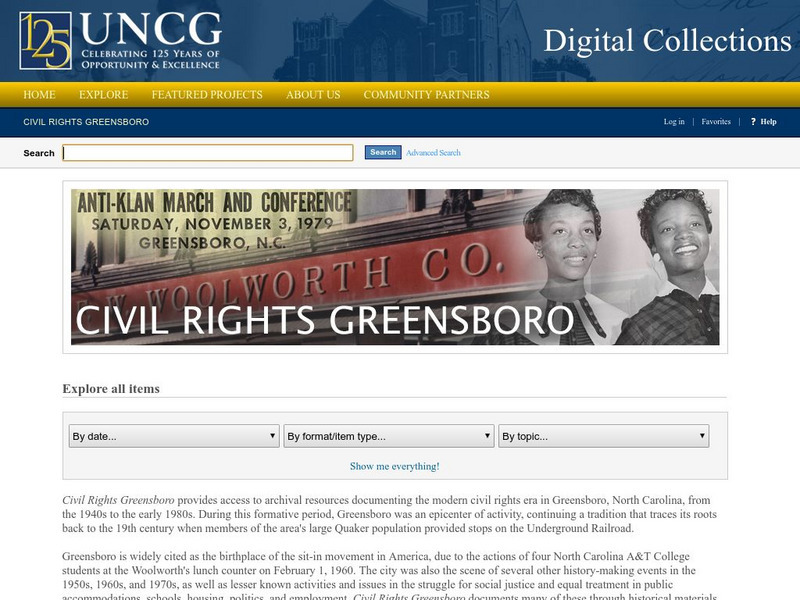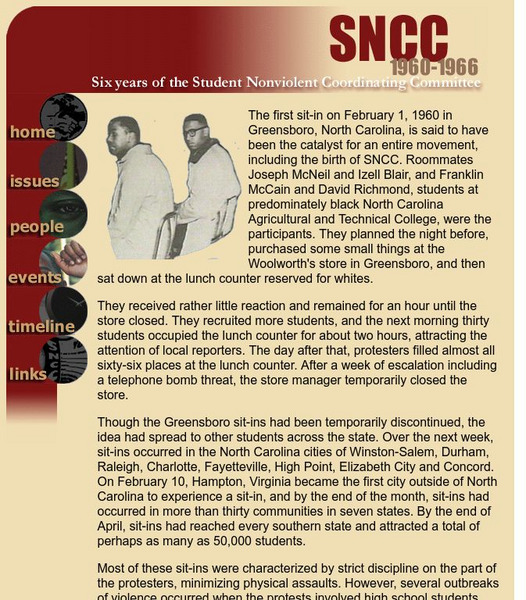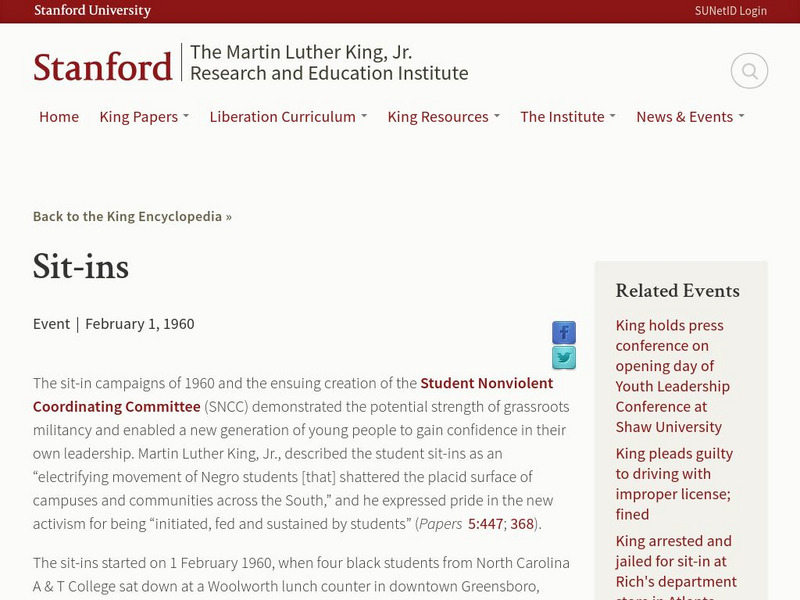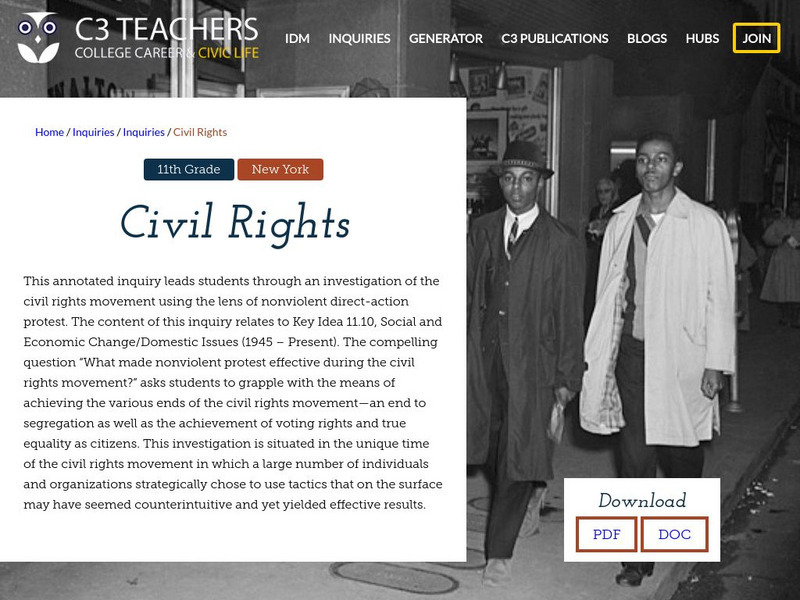Hi, what do you want to do?
Curated OER
The Greensboro Sit-Ins: A Continuing Tradition of Nonviolent Protest
Students watch a video about nonviolent protests during the Civil Rights Movement. They discuss and write about the Greensboro sit-ins while deciding the effectiveness of this type of protest.
Alabama Learning Exchange
African American Civil Rights Movement
An excellent resource defines the African-American Civil Rights Movement from the early 1900s through the legacy left in modern times. Every major date, event, and key player is described under clear overarching categories. The NAACP,...
PBS
Breaking the Code: Actions and Songs of Protest
Ezell Blair, Jr., David Richmond, Franklin McCain and Joseph McNeil changed history. Their sit-in at the lunch counter of the Woolworths in Greensboro, North Carolina on February 1, 1960 became a model for the nonviolent protests that...
Teaching Tolerance
Civil Rights Activity Book
An activity booklet includes a timeline of the movement, a song, and various informational reading passages on leaders, events, and the Civil Rights Memorial in Washington DC. Reading response questions and word puzzles are sure to...
Curated OER
Breaking the Code: Actions and Songs of Protest
Students listen to and discuss the purpose of protest music. They analyze an editorial cartoon related to Jim Crow and read questions from the literacy tests given to African-Americans. They work together to write a song about the...
Curated OER
The Student Non-Violent Coordinating Committee
Students identify and analyze the motivation behind the African-American students in organizing the sit-in if Greensboro and the formation of the SNCC. Students identify how the generational differences between members of SNCC and other...
Curated OER
African-American Civil Rights in the U.S.
In this African American history worksheet, high schoolers respond to 39 identification questions that require them to define or list the significance behind 39 events and people associated with the American Civil Rights Movement.
Atlanta History Center
Civil Disobedience and the Atlanta Student Movement
What tactics are used in civil disobedience? Learners study the conditions in Alabama that led to the establishment of the Atlanta Student Movement, as well as consider the nature and effectiveness of civil disobedience.
Curated OER
Separate is Not Equal: Brown vs. Board of Education
Brown vs. Board of Education was a landmark case, but what other cases were influenced by its decision? By researching 1 of 14 civil rights legislative events, scholars follow this court case through recent events. Keeping in mind 6...
Curated OER
You Can, Too!
Students and their parents participate in a volunteer opportunity in their community in order to solve a problem. In this problem solving lesson plan, students reflect on historical problems and see how they can solve a current problem.
Curated OER
The Student Non-Violent Coordinating Committee
Students are introduced to the Student Non-Violent Coordinating Committee (SNCC), one of the "big 5" civil rights organizations (the other four were: the Urban League, NAACP, SCLC, and CORE). The SNCC is credited with having led the...
Curated OER
A Letter Read 'Round the World
High schoolers examine primary document to examine the concept of free assembly, and analyze Dr. Martin Luther King Jr's letter to the clergy to explain the rationale for this tactic to advance civil rights.
A&E Television
History.com: Greensboro Sit Ins
The Greensboro Sit-In was a critical turning point in Black history and American history, bringing the fight for civil rights to the national stage. Its use of nonviolence inspired the Freedom Riders and others to take up the cause of...
Other
Civil Rights Greensboro: Greensboro Sit Ins at Woolworth's
A very detailed description of the sit-ins at the Greensboro, North Carolina, Woolworth's store and other businesses in that city during the first part of 1960. These sit-ins were to call attention to the segregation of public businesses...
Other
Greensboro Sit Ins: James Farmer
This resource provides a brief description of Farmer's role in support of the Greensboro sit-ins. An audio clip is included.
Other
North Carolina History Project: Greensboro Sit In
Learn about the sit-in at the Woolworth store in Greensboro, North Carolina.
Other
Veterans of the Civil Rights Movement: The Sit Ins
Find photographs of many of the sit-ins at lunch counters in stores in the South to protest "whites only" laws. Each photo has information about the sit-ins and the results.
ibiblio
Ibiblio: Greensboro Sit Ins
This site, which is provided for by Ibiblio, contains a background of the beginning and subsequent spread of the sit-ins during the 1960s.
National Women’s History Museum
National Women's History Museum: The Sit in Movement
Being served at a lunch counter was normal for whites, but African Americans were not allowed to sit at lunch counters throughout the South. Learn details of the Greensboro Sit-In.
Stanford University
Mlk and the Global Freedom Struggle: Sit Ins
Read about the organization behind the sit-ins at southern businesses, first in Greensboro, North Carolina, then spread throughout the south. Of interest is the prominence of student-led protest. Be sure to look at the related events and...
Smithsonian Institution
National Museum of American History: Students "Sit" for Civil Rights
Read the book, "Freedom on the Menu" about the Greensboro Sit-Ins and use the background information and follow up activities provided to enhance the story.
NBC
Nbc Learn: Finishing the Dream: 1960 1962: Freedom Fighters
A collection of archival video clips covering protests against racial segregation in the United States in the period 1960-1962. Features clips on the Greensboro sit-in at Woolworth's lunch counters, Freedom Riders who fought bus...
C3 Teachers
C3 Teachers: Inquiries: Civil Rights
A learning module on the use of nonviolent protests during the civil rights movement. It includes several supporting questions accompanied by formative tasks and source materials, followed by a summative performance task. Topics covered...
Independence Hall Association
U.s. History: The Sit in Movement
Just like the Montgomery Bus Boycott, the first sit-in at a Woolworth's lunch counter was the beginning of a nonviolent movement to challenge "white only" laws. Read about how the sit-in movement spread across the South. See how...

























